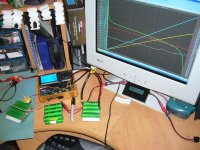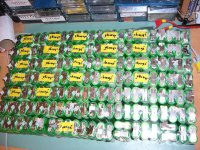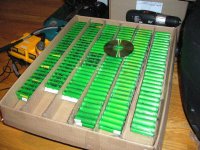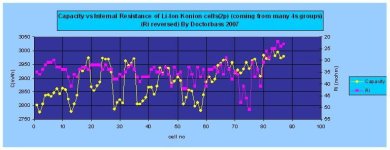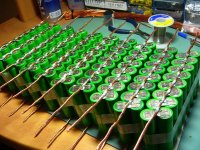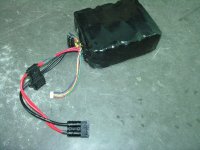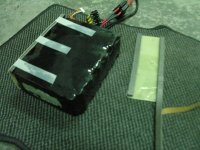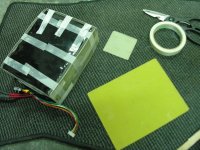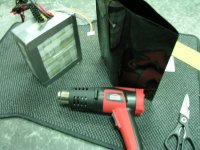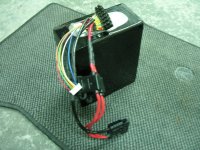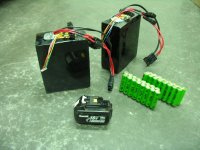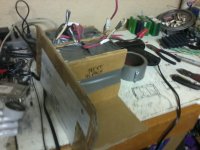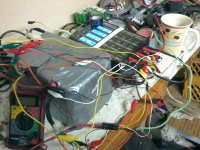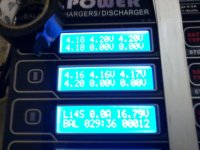Doctorbass
100 GW
A bit of History:
Back in the begining of 2007 I introduced these cells from Makita battery pack to the E-bike world.
I am not the very first person who used them other than for powertools. The RC crowd.. mainly from Germany already used them as great powerfull cells ( the 186650V). That's from one of their link that i finally found the specs in 2008. Also, The Bionx Lithium battery are using them too. finally Bosh are also using them but they use the lower capacity model ( 18650VT)
Since it happened. The popularity of them grow up alot and became a great solution for simple, cheap and low maintenance lithium battery.
How they came to the E-S ?
After my uncle that work from Makita gaved me few used and deffective battery i tested them alot and finally made my firsts ebike battery pack.
I still get some from him that i share with the E-S and to thanks him about that generosity, i built him an ebike with some of these cells.
The qty i can get from him is really interesting and i can supply and share my overstock to the E-S when i can.
I am one of the big supplier of these used or deffective packs.
As i said, these packs i get are all returned from custommers because they are deffective.
Some have just few cycles on them and some have over 400 cycles... But i asked my uncle to only give me the one that have 100 cycles of less. He have the special computerized makita tool to test them. By that way that ensure all cells had their burn-in and have more chance to work for their entire life compared to brand new cells.
These cells are called : KONION i have to say.. i really dont know why they call them like that but i know it come from the german wensite.
They are made by SONY since around 2005-2006 and still exist today
They are lithium manganese and exist in two models:
18650V and 18650VT.. some rare 26650VT model exist but they are difficult to find)
18 is for 18mm diameter and 650 for 65.0mm lengh
They come in different pack on the market:
The 18650V are used in:
-The BL1830 makita pack of 18V 3.0Ah
-The BionX electric bike battery of 24V and 37V 9.6Ah
The 18650VT are used in:
-The BL1815 makita pack of 18V 1.5Ah ( but they have 1.3Ah real)
-The Bosh 36V slim and fatpack
Here are their specs:
18650V: ( the most popular for ebikes)
( same as the Sanyo’s UR18650W)
-Voltage range: 3.0 to 4.2V
-Nominal voltage 3.7V
-Capacity: 1500mAh(10C) to 1600mAh(1C)
-Max Discharge C rate: 10C ( 15-16A)
-Max Charge C-rate: 1.5 to 2C depending on the cooling
-Cycle life: 700 cycles to 75% initial capacity ( from BMZ manufacture)
-Cycle life claimed by Makita: 1200 cycles
-Internal resistance 30miliohm per cells
-Released in 2005... still existing in 2011
-Weight: 44g
-Dimensions: 18mm dia and 65mm long
18650VT:
-Voltage range: 3.0 to 4.1 or 4.2V
-Nominal voltage 3.76V
-Capacity: 1030mAh(10C), 1080mAh, ( 1C) to 1300mAh(0.1C)
-Max Discharge C rate: 15C ( 17-20A)... and 30A for 30 sec
-Max Charge C-rate: 3C depending on the cooling
-Cycle life: 500 cycles to 90% of initial capacity, at 2A discharge ( from BMZ manufacture)
-Cycle life claimed by Makita: 1200 cycles
-Internal resistance :initial is 25 miliohm ( 26-28 miliohm of used cells)
-Gravimetric energy94 Wh/kg
-Released in 2005... still existing in 2011
Here is the specs from BMS compagny: ( see the attached file) ( please note that the Wh of the 18650V at 1C is not 3.61Wh but is 5.61Wh.. this is an typing error in the specsheet
BMS ??
These cells are well appreciated because they do not require balancing wich normally cost time and money to acheive on diy battery.
The 2010 and older Makita packs and the Bionx pack dont have any balance circuit in them.
it's not magic but it's still something we dont really understand.
While they do not require balancing, they must have something that will cut the current like a LVC to protect overdiacharge.. and also to be protected against overcharge.
When assembling them into a DIY battery they MUST all be at the same voltage before to parallel them and to charge the pack.
Info: Here is a document from the NASA Aerospace Flight Battery Program that tested some of the VT cells:
http://ntrs.nasa.gov/archive/nasa/casi.ntrs.nasa.gov/20100028067_2010030204.pdf
Why the Konion?
- Because they are cheap when bought as used packs, ( around 30 cent per Wh)
- Because they can give high power
- Because they dont NEED balancing
- Because THEY ARE SAFE chemistry
- Because you have a great source :wink:
They dont like: heat above 50 celsius.. it damage permanently them
that's why i recommand to keep the nickel strip already spotwelded on them and to solder on these nickel parts... dont solder directly on the cell tab! that will produce damaging gas inside that will act as an insulator between the layers and will oxidize them.
Getting some:
From now it probably exist over 200 persons that made battery using them on the E-S and as far as i know, you all appreciate them.
Some that got some from me in 2008 are still asking to get more to build more pack.
My Konion packs
In 2008 i decided to build the biggest ebike pack ever built.
It have 432 of the 18650V cells and is divided in 4 independent packs of 6s 16P ( i updated it to 18P few month later
Today in 2011 i still use it and still never need to balance it.
UPDATE 2017!!
HOW TO DISASSEMBLE MORE RECENT MAKITA PACKS
[youtube]Oz6Uis05ewA[/youtube]
To give you a teaste of what look like one of my diy pack made with makita:
Back in the begining of 2007 I introduced these cells from Makita battery pack to the E-bike world.
I am not the very first person who used them other than for powertools. The RC crowd.. mainly from Germany already used them as great powerfull cells ( the 186650V). That's from one of their link that i finally found the specs in 2008. Also, The Bionx Lithium battery are using them too. finally Bosh are also using them but they use the lower capacity model ( 18650VT)
Since it happened. The popularity of them grow up alot and became a great solution for simple, cheap and low maintenance lithium battery.
How they came to the E-S ?
After my uncle that work from Makita gaved me few used and deffective battery i tested them alot and finally made my firsts ebike battery pack.
I still get some from him that i share with the E-S and to thanks him about that generosity, i built him an ebike with some of these cells.
The qty i can get from him is really interesting and i can supply and share my overstock to the E-S when i can.
I am one of the big supplier of these used or deffective packs.
As i said, these packs i get are all returned from custommers because they are deffective.
Some have just few cycles on them and some have over 400 cycles... But i asked my uncle to only give me the one that have 100 cycles of less. He have the special computerized makita tool to test them. By that way that ensure all cells had their burn-in and have more chance to work for their entire life compared to brand new cells.
These cells are called : KONION i have to say.. i really dont know why they call them like that but i know it come from the german wensite.
They are made by SONY since around 2005-2006 and still exist today
They are lithium manganese and exist in two models:
18650V and 18650VT.. some rare 26650VT model exist but they are difficult to find)
18 is for 18mm diameter and 650 for 65.0mm lengh
They come in different pack on the market:
The 18650V are used in:
-The BL1830 makita pack of 18V 3.0Ah
-The BionX electric bike battery of 24V and 37V 9.6Ah
The 18650VT are used in:
-The BL1815 makita pack of 18V 1.5Ah ( but they have 1.3Ah real)
-The Bosh 36V slim and fatpack
Here are their specs:
18650V: ( the most popular for ebikes)
( same as the Sanyo’s UR18650W)
-Voltage range: 3.0 to 4.2V
-Nominal voltage 3.7V
-Capacity: 1500mAh(10C) to 1600mAh(1C)
-Max Discharge C rate: 10C ( 15-16A)
-Max Charge C-rate: 1.5 to 2C depending on the cooling
-Cycle life: 700 cycles to 75% initial capacity ( from BMZ manufacture)
-Cycle life claimed by Makita: 1200 cycles
-Internal resistance 30miliohm per cells
-Released in 2005... still existing in 2011
-Weight: 44g
-Dimensions: 18mm dia and 65mm long
18650VT:
-Voltage range: 3.0 to 4.1 or 4.2V
-Nominal voltage 3.76V
-Capacity: 1030mAh(10C), 1080mAh, ( 1C) to 1300mAh(0.1C)
-Max Discharge C rate: 15C ( 17-20A)... and 30A for 30 sec
-Max Charge C-rate: 3C depending on the cooling
-Cycle life: 500 cycles to 90% of initial capacity, at 2A discharge ( from BMZ manufacture)
-Cycle life claimed by Makita: 1200 cycles
-Internal resistance :initial is 25 miliohm ( 26-28 miliohm of used cells)
-Gravimetric energy94 Wh/kg
-Released in 2005... still existing in 2011
Here is the specs from BMS compagny: ( see the attached file) ( please note that the Wh of the 18650V at 1C is not 3.61Wh but is 5.61Wh.. this is an typing error in the specsheet
BMS ??
These cells are well appreciated because they do not require balancing wich normally cost time and money to acheive on diy battery.
The 2010 and older Makita packs and the Bionx pack dont have any balance circuit in them.
it's not magic but it's still something we dont really understand.
While they do not require balancing, they must have something that will cut the current like a LVC to protect overdiacharge.. and also to be protected against overcharge.
When assembling them into a DIY battery they MUST all be at the same voltage before to parallel them and to charge the pack.
Info: Here is a document from the NASA Aerospace Flight Battery Program that tested some of the VT cells:
http://ntrs.nasa.gov/archive/nasa/casi.ntrs.nasa.gov/20100028067_2010030204.pdf
Why the Konion?
- Because they are cheap when bought as used packs, ( around 30 cent per Wh)
- Because they can give high power
- Because they dont NEED balancing
- Because THEY ARE SAFE chemistry
- Because you have a great source :wink:
They dont like: heat above 50 celsius.. it damage permanently them
that's why i recommand to keep the nickel strip already spotwelded on them and to solder on these nickel parts... dont solder directly on the cell tab! that will produce damaging gas inside that will act as an insulator between the layers and will oxidize them.
Getting some:
From now it probably exist over 200 persons that made battery using them on the E-S and as far as i know, you all appreciate them.
Some that got some from me in 2008 are still asking to get more to build more pack.
My Konion packs
In 2008 i decided to build the biggest ebike pack ever built.
It have 432 of the 18650V cells and is divided in 4 independent packs of 6s 16P ( i updated it to 18P few month later
Today in 2011 i still use it and still never need to balance it.
UPDATE 2017!!
HOW TO DISASSEMBLE MORE RECENT MAKITA PACKS
[youtube]Oz6Uis05ewA[/youtube]
To give you a teaste of what look like one of my diy pack made with makita:


